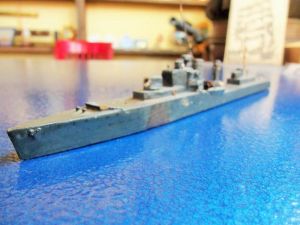HMS Maori WWII made by a crew member of this ship.
Price: NZ$201.09
Code: BH049
Intersting little War time model of HMS Maori made by a crew member of this ship.Simply made from wood and wire and painted and detailed in ship grey 10 1/4” 260mm long, this lovely little piece of sailor craft has a great story. Obviously a little worse for time and play it has survived with the story on the bottom layed out for anyone who would read the story of this proud little ship and its crew. This is the sort of thing that attracted me to the maritime theme of Boathouse Collectables the stories and hand skills of its people.Below is more info on this Tribal class destroyer from WWII if you are interested you can read on. The story of the hunt for the Bismarck is well worth a read, she was an amazing ship well ahead of her time with a brave crew, who fought insurmountable odds really,in the tradition of the proud German kriegsmarine which was not under the heel of it’s Nazi political leaders in many ways.
http://www.kbismarck.com/archives/bpressart1.html
Crippled Bismarck Fought Destroyers
Before Torpedo Sent Her Down
enemy was now lost in low visibility. The enemy was then approximately 350 miles south-southeast of the southern point of Greenland. Searching dispositions were at once taken up by other units of the Royal Navy. The main body of the Home Fleet, under the command of Admiral J. C. Tovey, K.C.B., D.S.O., with his Flag in H.M.S. King George the Fifth (Captain W. R. Patterson, C.V.O., R.N.), was steaming at high speed in a south-westerly direction from northern waters. Another force under the command of Vice-Admiral Sir James F. Somerville, K.C.B., D.S.O., with his Flag flying in H.M.S. Renown (Captain R. R. McGrigor, R.N.) was steaming north-westwards at high speed from Gibraltar. H.M.S. Rodney (Captain F. H. G. Dalrymple Hamilton, R.N.), H.M.S. Ramillies (Captain A. D. Read, R.N.), who were escorting convoys in the North Atlantic, proceeded to move in the direction of the enemy.
Plane Finds Bismarck Again
Extensive air searches were organised by Coastal Command and by the Royal Canadian Air Force stationed in Newfoundland. It was not until about 10.30 a.m on May 26 that the enemy was again located. At that time the Bismarck was sighted by a Catalina aircraft of Coastal Command in a position about 550 miles west of Land’s End. This aircraft was attacked and as a result lost touch with the enemy battleship half an hour later, but at 11.15 a.m. the Bismarck was sighted by naval aircraft operating from H.M.S. Ark Royal (Captain L. E. H. Maund, R.N.). Only the battleship Bismarck was seen, and she was then steering an easterly course. At this time H.M.S. King George the Fifth and H.M.S. Rodney were approaching the area, but were not yet sufficiently close to bring the enemy to action. As soon as Bismarck was sighted by Ark Royal’s aircraft Admiral Sir James Somerville detached the cruiser H.M.S. Sheffield (Captain C. A. A. Larcom, R.N.) to make contact with and shadow the Bismarck. During the afternoon a striking force of naval aircraft was dispatched from H.M.S. Ark Royal to attack with torpedoes, but this proved unsuccessful. Shortly after 5.30 p.m. H.M.S. Sheffield made contact with the Bismarck and proceeded to shadow her. Within 20 minutes another striking force of naval aircraft was flown off by H.M.S. Ark Royal.
Destroyers Go Into Action
This force attacked successfully, and one torpedo was seen to hit the Bismarck amidships. A second hit was obtained by a torpedo on the starboard quarter of the German battleship. It was subsequently reported that on being hit during this attack, the Bismarck made two complete circles, and that her speed was again reduced. During the evening some of our destroyers of the Tribal class, under the command of Captain P. L. Vian, D.S.O., R.N., in H.M.S. Cossack, made contact soon after 11 p.m. Between 1.20 a.m. and 1.15 a.m. on May 27 the Bismarck was attacked by torpedoes by H.M.S. Zulu (Commander H. R. Graham D.S.O., R.N.), H.M.S. Maori (Commander H. D. Armstrong, D.S.C., R.N.), and H.M.S. Cossack. H.M.S. Cossack and H.M.S. Maori each hit with one torpedo. After H.M.S. Maori’s attack it was reported that there was a fire on the forecastle of the German battleship. One hour after these attacks by our destroyers it was reported that the Bismarck appeared to be stopped. She was then about 400 miles due west of Brest, and had been pursued by our forces for more than 1,750 miles. It was subsequently reported that the Bismarck was again under way, and had made good about eight miles in one hour, and that she was still capable of heavy and accurate gunfire. At daylight on May 27 another striking force of naval aircraft was dispatched from H.M.S. Ark Royal, but this had to be cancelled owing to low visibility.
Cruiser Gave the Coup de Grace
Shortly after daylight the Bismarck engaged our destroyers by gunfire. H.M.S. Norfolk was in action with the Bismarck almost immediately afterwards and very soon the Bismarck was being engaged by our heavy ships. Details of this phase of the action have not yet been received. It is known, however, that H.M.S. Dorsetshire, Capt. B. C. S. Martin, R.N., was ordered to sink the Bismarck with torpedoes. Bismarck sank at 11.01 this morning. So far as is known at present (ends the communique) the only damage sustained by H.M. ships other than H.M.S. Hood is the slight damage to H.M.S. Prince of Wales already referred to.














